最新湘少版五下unit 10 Where were you yesterday教案
- 格式:doc
- 大小:62.50 KB
- 文档页数:5
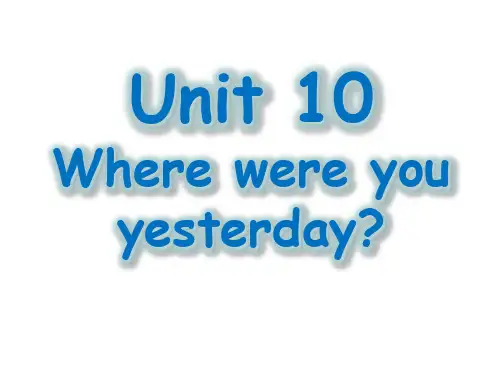
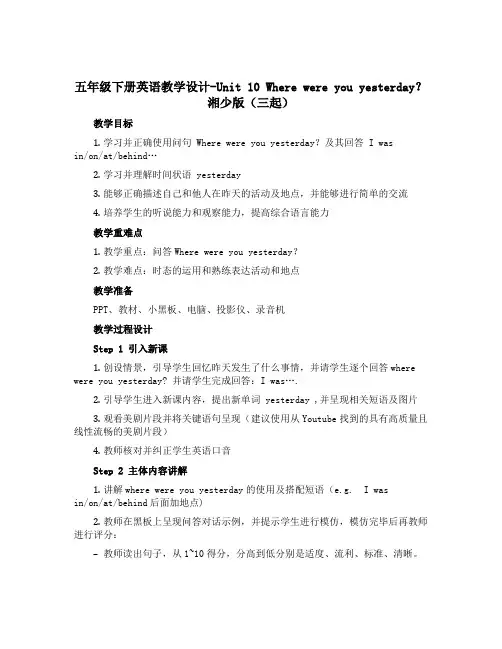
五年级下册英语教学设计-Unit 10 Where were you yesterday?湘少版(三起)教学目标1.学习并正确使用问句 Where were you yesterday?及其回答 I wasin/on/at/behind…2.学习并理解时间状语 yesterday3.能够正确描述自己和他人在昨天的活动及地点,并能够进行简单的交流4.培养学生的听说能力和观察能力,提高综合语言能力教学重难点1.教学重点:问答Where were you yesterday?2.教学难点:时态的运用和熟练表达活动和地点教学准备PPT、教材、小黑板、电脑、投影仪、录音机教学过程设计Step 1 引入新课1.创设情景,引导学生回忆昨天发生了什么事情,并请学生逐个回答where were you yesterday? 并请学生完成回答:I was….2.引导学生进入新课内容,提出新单词 yesterday ,并呈现相关短语及图片3.观看美剧片段并将关键语句呈现(建议使用从Youtube找到的具有高质量且线性流畅的美剧片段)4.教师核对并纠正学生英语口音Step 2 主体内容讲解1.讲解where were you yesterday的使用及搭配短语(e.g. I wasin/on/at/behind后面加地点)2.教师在黑板上呈现问答对话示例,并提示学生进行模仿,模仿完毕后再教师进行评分:–教师读出句子,从1~10得分,分高到低分别是适度、流利、标准、清晰。
I was in the park. ( ) I was at the cinema. ( ) I was behind the desk. ( )3.提炼常见短语,让学生在小组自学并进行教学,然后进行小组展示、评优(e.g. in the classroom、behind the door、at home)Step 3 合作巩固1.学生之间互相提问对方昨天在哪儿的问题,并询问对方昨天做了什么活动,进而练习使用where,when等短语2.指导学生编写课后练习题目,进行口语训练,例如:–请自己或者让爸爸、妈妈问你昨天在哪儿,你又在做什么呢?Step 4 作业布置请家长拍照,上传课堂学习过程照片,作为本周作业。
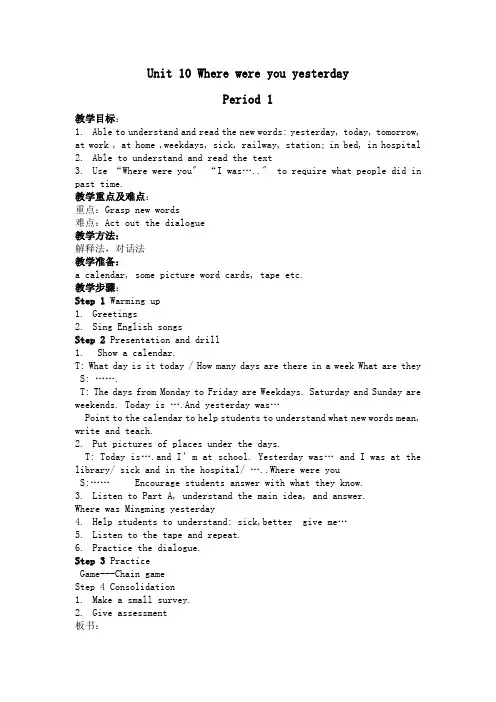
Unit 10 Where were you yesterdayPeriod 1教学目标:1. Able to understand and read the new words: yesterday, today, tomorrow, at work , at home ,weekdays, sick, railway, station; in bed, in hospital2. Able to understand and read the text3. Use “Where were you〞“I was…..〞 to require what people did in past time.教学重点及难点:重点:Grasp new words难点:Act out the dialogue教学方法:解释法,对话法教学准备:a calendar, some picture word cards, tape etc.教学步骤:Step 1 Warming up1. Greetings2. Sing English songsStep 2 Presentation and drill1. Show a calendar.T: What day is it today / How many days are there in a week What are they S: …….T: The days from Monday to Friday are Weekdays. Saturday and Sunday are weekends. Today is ….And yesterday was…Point to the calendar to help students to understand what new words mean, write and teach.2. Put pictures of places under the days.T: Today is….and I’m at school. Yesterday was… and I was at the library/ sick and in the hospital/ …..Where were youS:…… Encourage students answer with what they know.3. Listen to Part A, understand the main idea, and answer.Where was Mingming yesterday4. Help students to understand: sick,better give me…5. Listen to the tape and repeat.6. Practice the dialogue.Step 3 PracticeGame---Chain gameStep 4 Consolidation1. Make a small survey.2. Give assessment板书:yesterday today weekdays sickrailway stationWhere were you, MingmingI was…….Period 2教学目标:1. Able to understand Part D, and finish the questions教学重点及难点:重点:Understand Part D, and finish the questions难点:retell the part D教学方法:操练法教学准备:some pictures of scenery, word cards, tape etc.教学步骤:Step 1 Warming up1. Greetings2. Sing a song.Step 2 Presentation and drill1. Show pictures of scenery or photos, pin them on a blank paper)T: Hello, boys and girls. I like traveling very much. I’ve been to many places, for example, Shanghai, Beijing, Guangzhou…...They are all beautiful places. I took many pictures.Hand in the photos to the students; write the new words and phrases on the Bb.2. Read part D, and answer the questionsWhere was Mr White last weekWhy did he feel happy in HangzhouDid he like the food in GuangzhouWhy did Mr White love China3. Explain “cities visited saw weather sunny went said〞 to students.4. Listen to the tape and repeat.Step 3 Practice1. Talk out Part D.2. Discuss and finish the form.Weekdays Monday Tuesday Wednesday Thursday FridayPlaces3. Finish the questions, and then practice with your partner.Step 4 Consolidation1. Retell Part D2. Give assessment.3. Homework: Repeat the text.板书:Where were you yesterdayWhere were you onI was on .Weekdays Monday Tuesday Wednesday ThursdayFridayPlacesPeriod 3教学目标:1. Grasp the new words, sentences, grammar in the unit2. Able to describe where you went3. sing the song教学重点及难点:重点:Grasp and use the words难点:Use the knowledge to talk about where you went.教学方法:解释法,对话法教学准备:pictures, photos, word cards tape etc.教学步骤:Step 1 Warming up1. Greetings.2. Sing English song.3. Dictate the words and phrases in the unit.Step 2 Presentation and drill1. Point to Part E, and fill in the blanks.2. Check their answers.Step 3 Practice1.learn the song“Where Were You〞2.Change the lyrics “little lady, at home, sir〞 into “dear sir, at school, girl〞. And sing the song.3.Sing by boys and girls separately.Step 4 ConsolidationGame---Travel in the dream.Teacher plays a piece of piano, let students act as sleeping Homework板书:Where were youPeriod 2一、Teaching aims1. Enable the Ss listen, read, say and write the new words: learn words and sentences, , learn writing and price listening.2. Enable the Ss be familiar with the past tense.3. Sentence: What did ...do during the summer holidays二、Teaching emphasis: Enable the Ss listen, read, say and write the new words and talk about the past events.三、Teaching difficulties: Enable the Ss be familiar with the pas t tense.四、Teaching tools: Tape, pictures五、Teaching method Oral method六、Teaching steps:Step 1 Warming up1. Greetings and . Simon says: word list-, learn, write, talk, li sten, do, have, go, take, read, speak, teach and holidays.2. Make a conversation with the Ss. T: Glad to see you again. Ss: Glad to see you too. T: What did you do during the summer holidays S s: I went toHainan…Step 2 Presentation and drill1. Show the picture of “learn words and sentences〞. T: This isa picture of Mingming during the summer holidays. What did he do Ss: He is learning words and sentences.T: He is not doing it now. He learnt words and sentences during t he summer holidays.2. Learn the other words in the same way.3. Read together.4. Little teacher.Step 3 PriceT: He learnt words and sentences. They ed . She learnt writing. H e practised listening. (Action) learn words and sentences, play games, learn writing and practice listening…3. The Ss act and say.4. Listen to the tape of Part A and then answer these questions. What Anne do during the summer holidays What did Mingming do during t hesummer holidays 3. Listen and repeat.5. Act it out.Step 4 Consolidation 1. Evaluation. 2. Do Ex. 3.Homework. Copy the new words. Design of the blackboard:Period 2一、Teaching aims:1. Enable the Ss listen, read and say the dialogue;2. Enable the Ss the sentence pattern: What you do during theholidays3. Enable the Ss master read the short passages and judge True or False.二、Teaching emphasis: Enable the Ss listen, read and say the dia logue;三、Teaching difficulties: Enable the Ss master the sentence patt ern: What did you do during the holidays四、Teaching tools: Tape, pictures五、Teaching method Oral method六、Teaching steps:Step 1 Warming up1. Greetings.2. Act and say. 1). (Action) learn words and sentences, , learnwriting and price listening… 2). Tom: I played games. Ss: Tom pl ayedgames. …Step 2 Presentation and drill 1. Listen to the tape and learn the Word Bank. What you do during the holidays I read many book s. I visi ted mygrandparents. I played games with my friends.Step 3 Practice1. Listen to the tape and repeat.2. Pair-work.3. Group-work .Step 4 Let’s Read1. Read the short passage and then judge True or Flase.2. Read the passage again and underline the key sentences.3. Check the answers.Step 5 Consolidation1. Evaluation.2. Do Ex3. Homework. Design of the blackboard:Period 3一、Teaching aims:1. Enable the Ss talk about their holidays.2. Enable the Ss and write down their holidays.二、Teaching emphasis: Enable the Ss describe their holidays.三、Teaching difficulties: Enable the Ss to talk about and write down theirholidays四、Teaching tools: Tape五、Teaching method Oral method六、Teaching steps:Step 1 Warming up1. Greetings.2. Read Part A together.3. Step 2 Presentation and drill1. Ask students to talk about their summer holidays and then let them finish Part E: write down your answers2. Check the answer.3. Ask two Ss to talk about their answers.Step 3 Let’s Have Fun1. Class work. Look at the pictures, describe Mingming’s and Ann e’s holidays.2. Class work. describe your holidays.Step 4 Consolidation1. Do Ex. Work book Unit 1.2. Evaluation3. Homework. Revise Unit 1. Design of the blackboard:2、Katie always gets up early. Period 1Teaching aims.1.The aims of knowledge:Learn these new words: wake up; make the bed; wave; late always; usually; often; never.2. The aims of skills:a. Ss can understand the four –skill words: wake up; make thebed; wave; lateb. Ss can understand the words: always; usually; often; never.c. Ss can describe the other’s actions.3.Emotion, attitudes and valueTo form the health living habitMain points and difficult point:The students master the words: wake up; make the bed; wave; late; always; usually; often; never.Teaching method and Learning way:TPR; T ask-based method; Discussing Teaching aids : Cards, tape ,r ecord, picturesTeaching Process: Step 1 Warming up a. Greetings.b. sing a song: London Bridge is falling downc. Free talk. Talking about my day.Step 2 Reviewa. Game—Guess ,guess, guessUse the cards to go over the wordsb. Retell the story—Unit 1Step 3 Presentationa. Learn the words and expressions:wake up; make the bed; wave; late At first show the learned word: cake .Let the studentsread the word, then write the words carefully.From above to find out the rules of pronunciation and memory word s.Wake up.e.g. a. What time do you usually wake upb. I usually wake up at 6.make the bede.g. a. Do she make the bed in the morningb. The first thing he does after getting up is to makethe bed.wave a greeting挥手致意late.e.g. I’m latelate autumn暮秋, 深秋get up late睡懒觉 wave good-bye to sb. 挥手辞别b. Let the students understand frequency Adverbs(频率副词):always often usually never alwaysRead these words several times and try to remember them. At the s ame time, explain the meanings of different adverbs of frequency.100% alwaysI always stay at home in the evenings.90% usuallyI usually wake up early.80% oftenHe often goes to school on foot.0% neverHe never goes to school late.Step 3. PracticePractice the words. a. Game 1. Loud and low voice. b. Game 2. Qui ck response The teacher brings out some pictures and word cards, the students speak out the words quickly.c. Game 3. Guessing gameWriting on blackboard:2、Katie always gets up early.Period 2 Teaching aims:A. Knowledge and skillsa. Learn Part A Let’s listen and say. Katie’s Day.b. Grasp the usage of adverbs of frequency. B. Processes and methodsa. With the studying strategies, get the students to work in pair s or groups to talk about their day.b. Let the students practice spe aking and writing. C. Emotion, attitudes and valueThe content of this part is close to the students’ daily life an d the topic deals with the students’ daily activities, so it is help ful for the students to learn about more daily activities. It can hel p the students to carry on the language practice about the topic and to arouse their great interest in learning English; On the other hand, it provide the students with opportunities to understand one another better. Teaching difficulties and focuses: a. Ss can use the present tense of the third personget-gets make-makes wash-washes run-runs leave-leaveshave-hasb. Ss can master sentence structure: sb do sth at some time Teach ing method:Task-based Learning MethodTeaching aids:Cards, recorder and some objectsTeaching Process: Step 1 Warming up a. Greetings.b. sing a song Step 2 ReviewGame—Golden finger Use the cards to go over the wordsStep 3 Presentation and drilla. Listening to the recorderb. T: You’re very good. You are all good pupils. And Katie is a good pupil too. Everyone likes her. She is never late for school. She always gets up early every day . Then she makes bed .after breakfast, she waves her family goodbye.c. Fast reading the text.d. Answer the following questions.Does Katie always gets up earlyWhat time does Katie wash her faceWhat time does Katie make her bedIs Sally is often lateWhat time does Katie’s father leave for work e. Explain the gram mar for the pupils: The present tense of the third person. get-gets m ake-makes wash-washes run-runs leave-leaveshave-hase.g.Step 4 Practicea. Reading the text carefully.b. Listen and repeat itc. Retell it , check the resultd. Practice in pairs, according t o the form to saysomething about their day.Step5 Consolidationa. Part C About the story.Put a tick(√)if the sentencescorrect of a cross(×)if they are wrong.1. Katie always gets up at six o’clock. (√)2. Katie always washes her face at 6:15 am. (×)3. Katie’s family often has breakfast at 6:45 am. (×)4. Sally always goes to the breakfast table on time. (×)5. Katie’s father u sually waves then goodbye. (√)b. Homework: Listen and read the dialogue, copy the newwordsWriting on blackboard: 2、Katie always gets up early.get - getsmake - makeswash - washesrun - runsleave - leaves have - hasTeaching aims. a. Going over words.b. Retell the story. Main points: Period 3c. Finish Part D, E, F. The students can master the words and sentences.Difficult point: Teaching aids:Teaching Process:Step 1 Warming up a. Greetings.b. Sing a song. Step 2. Reviewa. Play a game –magic eyes The students can describe the other’s actions cards,tape ,record c. Free talk: Say something about your d aily life Going over the learned words: slide, bench, bark, chain, sw ing, stone, bite, wake up, make the bed, have, late.always, usually, often, never.b. Use the cards to go over the new dialogue ,and make sentences with the present tense ,they are required not to make the s ame sentencesc. Retell the story Step 3 Drillsa. Part D. Pair work. Look at the chart. Take turns to tell each other about Peter’s activities.Example: Peter usually goes to bed at ten o’clock.Write four sentences about your activities.2、I never go to school by bus.Exemple: I usually do my homework at six o’clock.3、I often watch TV at 6: 30 in the evening.114、I usually go to bed at 10:00 pm.b.Part E Listen to the tape and requires them to finish12Now, write suitable answers in the blanks.3.Listen to tape and follow it Step 4 Consolidationa. Make a situation and have a dialogue with their partners, choo se some to act it outb. Homework: Listen and read the dialogue, copy the words ,and tr y to recite textWriting on blackboard:2、Katie always gets up early.。

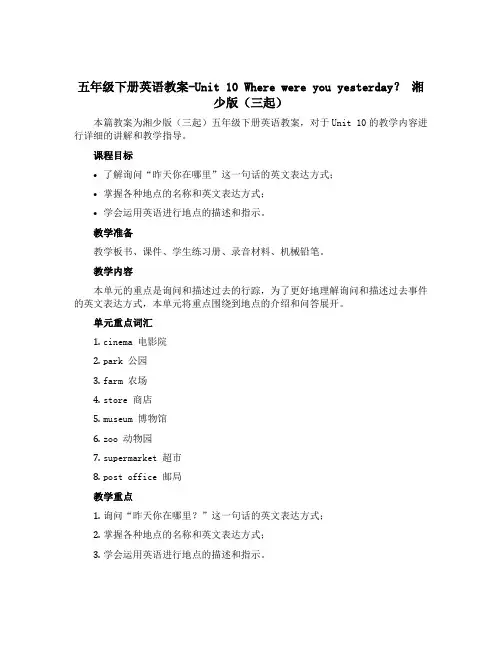
五年级下册英语教案-Unit 10 Where were you yesterday?湘少版(三起)本篇教案为湘少版(三起)五年级下册英语教案,对于Unit 10的教学内容进行详细的讲解和教学指导。
课程目标•了解询问“昨天你在哪里”这一句话的英文表达方式;•掌握各种地点的名称和英文表达方式;•学会运用英语进行地点的描述和指示。
教学准备教学板书、课件、学生练习册、录音材料、机械铅笔。
教学内容本单元的重点是询问和描述过去的行踪,为了更好地理解询问和描述过去事件的英文表达方式,本单元将重点围绕到地点的介绍和问答展开。
单元重点词汇1.cinema 电影院2.park 公园3.farm 农场4.store 商店5.museum 博物馆6.zoo 动物园7.supermarket 超市8.post office 邮局教学重点1.询问“昨天你在哪里?”这一句话的英文表达方式;2.掌握各种地点的名称和英文表达方式;3.学会运用英语进行地点的描述和指示。
教学步骤Step 1. 导入新课通过设问的方式,引入新课,让学生在思考中逐渐进入新的学习内容。
示例问题:Do you like going to the cinema? 如果大家常去电影院,那我们应该怎么问别人昨天是否去过电影院呢?Step 2. 学习新词汇介绍本单元的重点词汇,教师出示图片,让学生尝试猜测单词名称,并逐一讲解单词的意思和发音,并通过例句来展示其使用方法。
Step 3. 听力练习播放录音,让学生根据录音内容进行听力练习,听懂听。
问提问:•Where were you yesterday?•Can you show me the way to the supermarket/ zoo?Step 4. 地点描述和指示让学生尝试运用新学习到的单词和英语句子,模拟情景,描述和指示对方去某个地方的方法。
如:•A: Excuse me, can you tell me the way to the park?•B: Sure. Go straight from here, turn left at the jasmine tree. You will see the park on your left.•A: Thank you.Step 5. 练习训练针对所学内容,让学生进行相关练习。
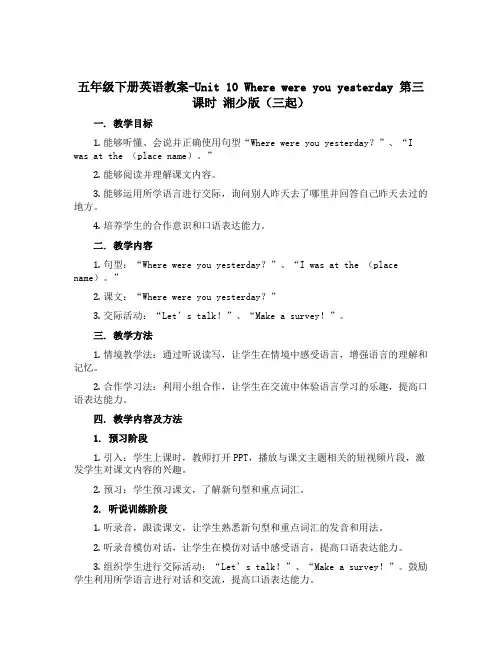
五年级下册英语教案-Unit 10 Where were you yesterday 第三课时湘少版(三起)一. 教学目标1.能够听懂、会说并正确使用句型“Where were you yesterday?”、“I was at the (place name)。
”2.能够阅读并理解课文内容。
3.能够运用所学语言进行交际,询问别人昨天去了哪里并回答自己昨天去过的地方。
4.培养学生的合作意识和口语表达能力。
二. 教学内容1.句型:“Where were you yesterday?”、“I was at the(place name)。
”2.课文:“Where were you yesterday?”3.交际活动:“Let’s talk!”、“Make a survey!”。
三. 教学方法1.情境教学法:通过听说读写,让学生在情境中感受语言,增强语言的理解和记忆。
2.合作学习法:利用小组合作,让学生在交流中体验语言学习的乐趣,提高口语表达能力。
四. 教学内容及方法1. 预习阶段1.引入:学生上课时,教师打开PPT,播放与课文主题相关的短视频片段,激发学生对课文内容的兴趣。
2.预习:学生预习课文,了解新句型和重点词汇。
2. 听说训练阶段1.听录音,跟读课文,让学生熟悉新句型和重点词汇的发音和用法。
2.听录音模仿对话,让学生在模仿对话中感受语言,提高口语表达能力。
3.组织学生进行交际活动:“Let’s talk!”、“Make a survey!”。
鼓励学生利用所学语言进行对话和交流,提高口语表达能力。
3. 阅读训练阶段1.分组朗读课文,让学生熟悉课文内容和语言表达方式。
2.组织学生进行课文阅读理解练习,检查学生对课文的理解情况。
4. 书写训练阶段1.引导学生根据课文内容,编写简短对话或文章,锻炼学生的书写能力。
五. 教学评估1.组织学生进行互相评估,了解自己与他人的表现。
2.教师通过听、说、读、写的训练,检查学生的学习效果。
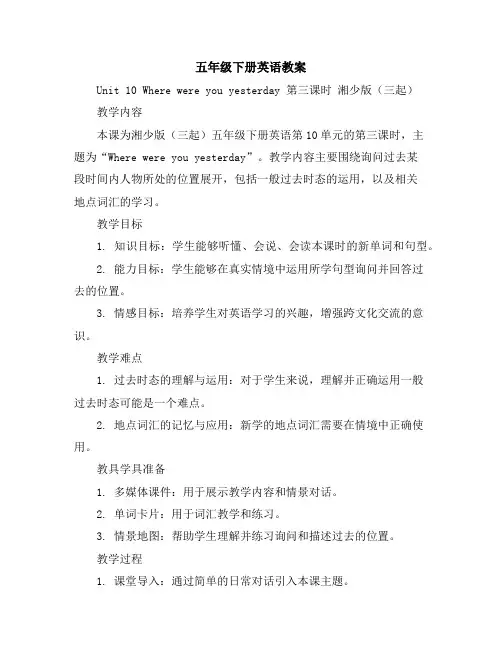
五年级下册英语教案Unit 10 Where were you yesterday 第三课时湘少版(三起)教学内容本课为湘少版(三起)五年级下册英语第10单元的第三课时,主题为“Where were you yesterday”。
教学内容主要围绕询问过去某段时间内人物所处的位置展开,包括一般过去时态的运用,以及相关地点词汇的学习。
教学目标1. 知识目标:学生能够听懂、会说、会读本课时的新单词和句型。
2. 能力目标:学生能够在真实情境中运用所学句型询问并回答过去的位置。
3. 情感目标:培养学生对英语学习的兴趣,增强跨文化交流的意识。
教学难点1. 过去时态的理解与运用:对于学生来说,理解并正确运用一般过去时态可能是一个难点。
2. 地点词汇的记忆与应用:新学的地点词汇需要在情境中正确使用。
教具学具准备1. 多媒体课件:用于展示教学内容和情景对话。
2. 单词卡片:用于词汇教学和练习。
3. 情景地图:帮助学生理解并练习询问和描述过去的位置。
教学过程1. 课堂导入:通过简单的日常对话引入本课主题。
2. 词汇教学:利用单词卡片教授新词汇。
3. 句型练习:通过情景模拟和角色扮演练习句型。
4. 小组活动:学生分组进行对话练习,巩固所学内容。
板书设计板书将包括本课的关键词汇、句型以及重点语法点。
通过清晰的布局和色彩区分,帮助学生更好地理解和记忆。
作业设计1. 书面作业:完成相关练习题,巩固语法和词汇。
2. 口头作业:与家长进行情景对话练习,提高口语能力。
课后反思课后反思将重点关注学生对过去时态的理解和应用情况,以及他们在实际对话中的表现。
教师将根据学生的反馈调整教学策略,以提高教学效果。
本教案旨在通过丰富的教学活动和实际应用,帮助学生掌握本课的核心内容,并能在实际生活中有效运用所学知识。
通过课后反思和作业设计,教师能够更好地了解学生的学习情况,并据此调整教学方法,以期达到最佳教学效果。
过去时态的理解与运用1. 情境创设:通过创设具体的情境,如“昨天的小聚会”、“上周末的旅行”等,让学生在情境中自然地使用过去时态。

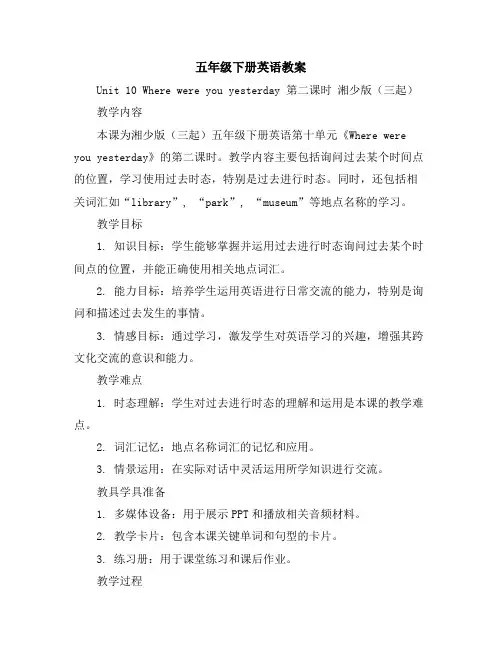
五年级下册英语教案Unit 10 Where were you yesterday 第二课时湘少版(三起)教学内容本课为湘少版(三起)五年级下册英语第十单元《Where were you yesterday》的第二课时。
教学内容主要包括询问过去某个时间点的位置,学习使用过去时态,特别是过去进行时态。
同时,还包括相关词汇如“library”, “park”, “museum”等地点名称的学习。
教学目标1. 知识目标:学生能够掌握并运用过去进行时态询问过去某个时间点的位置,并能正确使用相关地点词汇。
2. 能力目标:培养学生运用英语进行日常交流的能力,特别是询问和描述过去发生的事情。
3. 情感目标:通过学习,激发学生对英语学习的兴趣,增强其跨文化交流的意识和能力。
教学难点1. 时态理解:学生对过去进行时态的理解和运用是本课的教学难点。
2. 词汇记忆:地点名称词汇的记忆和应用。
3. 情景运用:在实际对话中灵活运用所学知识进行交流。
教具学具准备1. 多媒体设备:用于展示PPT和播放相关音频材料。
2. 教学卡片:包含本课关键单词和句型的卡片。
3. 练习册:用于课堂练习和课后作业。
教学过程1. 课堂导入:通过复习上一课时的内容,自然过渡到本课的学习。
2. 新知呈现:通过PPT展示新的单词和句型,并进行讲解和示范。
3. 互动练习:组织学生进行角色扮演,练习询问和回答过去的位置。
4. 巩固提升:通过小组活动,让学生在真实情境中运用所学知识。
板书设计Unit 10 Where were you yesterday关键词:过去进行时态,地点名称词汇核心句型:Where were you yesterday? I was at the作业设计1. 书面作业:完成练习册中与本课相关的练习题。
2. 口头作业:与家长或同学进行对话练习,询问并描述过去的位置。
课后反思课后反思主要包括对教学效果的评估、学生学习情况的观察以及教学方法的改进。
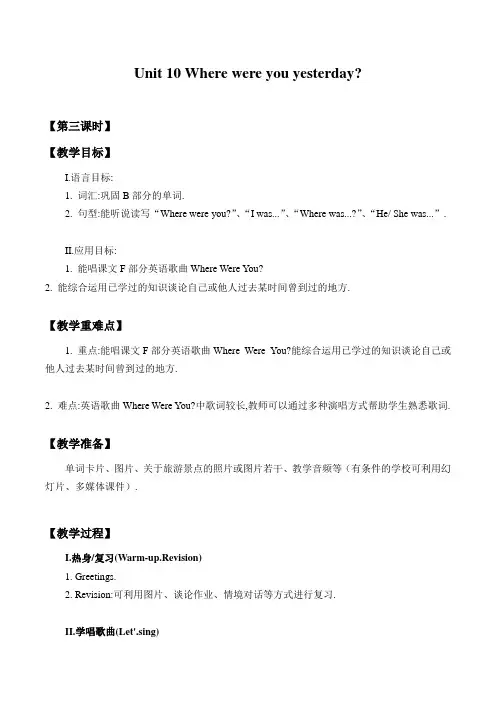
Unit 10 Where were you yesterday?【第三课时】【教学目标】I.语言目标:1. 词汇:巩固B部分的单词.2. 句型:能听说读写“Where were you?”、“I was...”、“Where was...?”、“He/ She was...”.II.应用目标:1. 能唱课文F部分英语歌曲Where Were You?2. 能综合运用已学过的知识谈论自己或他人过去某时间曾到过的地方.【教学重难点】1. 重点:能唱课文F部分英语歌曲Where Were You?能综合运用已学过的知识谈论自己或他人过去某时间曾到过的地方.2. 难点:英语歌曲Where Were You?中歌词较长,教师可以通过多种演唱方式帮助学生熟悉歌词.【教学准备】单词卡片、图片、关于旅游景点的照片或图片若干、教学音频等(有条件的学校可利用幻灯片、多媒体课件).【教学过程】I.热身/复习(Warm-up.Revision)1. Greetings.2. Revision:可利用图片、谈论作业、情境对话等方式进行复习.II.学唱歌曲(Let'.sing)1. 教师先在黑板上出示两张图片:一张图片为一位外国女士,另一张图片为一位外国男士.3. 跟随教师朗读歌词.4. 逐句跟唱英语歌曲.5. 男女学生对唱英语歌曲.6. 将歌词中little lady, at home, sir分别改为dear sir, at school, girl,教师和学生对唱该英语歌曲.III.趣味活动(Let'.hav.fun)游戏:Travel in the dream梦之旅.教师播放一段贝多芬的《月光曲》(钢琴曲),让学生们都伏在桌子上做睡觉状.同时教师将世界各地著名景点的图片和部分学生作品(最好写上英语名称)放在每个学生的课桌上.音乐停止后,学生就图片和教师进行交流,描述“所到之处”.T: Where were you?A. ..visite.th.Grea.Wall.Wher.wer.you?...【作业布置】1. 听音频,说唱歌谣.2. 完成课外练习.。

Unit 10 Where were you yesterday 第3课时 (教学设计) 湘少版(三起)英语五年级下册一、教学目标1.学习并掌握问答“Where were you yesterday?” “I was at the _____.”2.能够正确使用句式“It was _____ yesterday.”3.进一步提高学生的听说能力。
二、教学重难点1.句式的正确运用和语调的准确把握。
2.导入环节的设计,既能引发学生的兴趣,又能循序渐进地让学生进入学习状态。
三、教学过程1. Warm-up1.通过问答的方式复习之前学过的内容,如“What’s your name?”, “How old are you?”, “What’s your favorite color?”, etc.2.引入今天的学习内容:“Where were you yesterday?” “I was at the_____.”老师问孩子们之前有没有学过这个句子,在学过的小伙伴面前询问一两位学生昨天的去向。
2. Presentation1.老师播放一段音频,告诉学生这是一些同学昨天去了哪些地方,让学生听三遍音频。
2.老师呈现一个地图,让学生根据听到的音频找出对应的地点,边找边说。
3. Practice1.指导学生课堂上说话的方式。
老师向学生们展示语调上的差异,引导学生跟随老师模仿。
2.老师通过游戏的形式巩固学生的学习效果,将整个班分成两组,两组之间进行问答比赛。
4. Production1.让学生们随意应用所学知识写一个小短文,介绍一下自己昨天的去向和感受。
2.在班级内挑选一些优秀文章,分享给大家,展示自己的写作能力。
5. Extension1.让学生们根据自己的实际情况将所学知识运用到日常生活中。
2.老师布置一篇语文作业,让学生动笔写一篇可爱、有趣的日记,写出自己昨天的情况,或者写出自己即将去的地方,用所学英语句式书写。
Unit 10 Where were you yesterday?教案【教学目标】1. 知识目标:(1)学生能牢记该课新单词和短语:homework, sick, was in bed, fine, at home, all right, give,last week, yesterday, today, tomorrow, last monthat work, at home, in bed, in hospital(2)记住新句型、句子和语言知识点:Where’s your homew ork?Sorry, I was…Where were you yesterday?I was sick. I was in bed at home.Are you better now?Yes, I’m fine now. Thank you.All right. Please give me your homework tomorrow.Ok. Thank you, Miss Li.2. 能力目标:(1)学生能听懂对话录音,会和别人展开对话,能就类似话题,创造性地自编对话。
(2)能熟练运用新句型清楚回答相关问句。
(3)能够运用新句型进行情景会话。
3. 情感目标:(1)激发学生学习英语的兴趣,帮助学生树立学好英语的信心,培养学生热爱生活、热爱英语的态度,并在成功中体会英语学习的乐趣。
(2)增强学生的参与意识,培养学生团队合作意识和团队合作精神,引导学生积极与他人合作,共同完成学习任务。
(3)在教学过程中,环环相扣,激发学生学习英语的兴趣并培养正确的学习观。
(4)加强学生们之间的互相了解。
【教学重点】1. 掌握新单词和短语last week/yesterday/today/ tomorrow/at work/at home/in bed。
2. 能初步运用句型“ Where were you yesterday?” “I was at ....”。
五年级下册英语教案Unit 10 Where were you yesterday?湘少版(三起)教学内容本单元主题为“询问过去的位置”,主要围绕“Where were you yesterday?”这一问题展开。
教学内容包括过去时态的运用,特别是过去位置的表达,如“at the park”,“in the library”等。
同时,通过本单元的学习,学生将能够描述过去某个时间点的位置,并能够询问他人的过去位置。
教学目标1. 学生能够理解并运用过去时态描述过去的位置。
2. 学生能够正确使用“Where were you yesterday?”来询问他人的过去位置。
3. 学生能够通过对话练习,提高英语口语表达能力。
4. 学生能够培养对英语学习的兴趣和自信心。
教学难点1. 过去时态的运用,特别是“were”和“was”的选择。
2. 询问和描述过去位置的句型结构。
3. 词汇的记忆和应用。
教具学具准备1. 教学课件:包括图片、视频和音频资料。
2. 黑板和粉笔:用于板书和展示关键词。
3. 学生练习册:用于课堂练习和课后作业。
4. 录音设备:用于录制学生的对话练习。
教学过程1. 课堂导入:通过播放一段关于“Where were you yesterday?”的短视频,激发学生的兴趣。
2. 新知呈现:利用教学课件,展示本节课的重点词汇和句型。
3. 小组活动:学生分组进行对话练习,模拟询问和描述过去位置的场景。
4. 课堂练习:通过练习册上的习题,巩固学生对新知识的理解和应用。
板书设计1. 核心句型:“Where were you yesterday?”2. 重点词汇:如“park”,“library”,“school”等。
3. 过去时态的结构:如“I was at the park.”,“They werein the library.”等。
作业设计1. 完成练习册上的相关习题。
2. 编写一段关于“Where were you yesterday?”的对话。